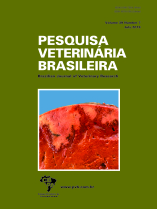 |
|
|
|
Year 2019 - Volume 39, Number 7
|

|
Clinical and blood gas analysis of calves conceived by artificial insemination, in vitro fertilization and animal cloning, 39(7):485-491
|
ABSTRACT.- Dantas G.N., Santarosa B.P., Benesi F.J., Santos V.H. & Gonçalves R.C. 2019. Clinical and blood gas analysis of calves conceived by artificial insemination, in vitro fertilization and animal cloning. [Análise clínica e hemogasométrica de bezerros concebidos por inseminação artificial, fertilização in vitro e clonagem animal.] Pesquisa Veterinária Brasileira 39(7):485-491. Faculdade de Medicina Veterinária e Zootecnia, Universidade Estadual Paulista, Campus de Botucatu, Distrito de Rubião Júnior s/n, Botucatu, SP 18618-970, Brazil. E-mail: gabrielan.dantas@gmail.com
In order for successful extra-uterine adaptation to occur, it is necessary for the neonate to be able to establish its respiratory functions effectively, guaranteeing efficient oxygenation and good vitality. Respiratory disorders are the major cause of death during the neonatal period in cattle, and this mortality is even more significant when it comes to calves originated by in vitro fertilization (FIV) or animal cloning (CA). Blood gas analysis assesses acid-base balance changes effectively, and when associated with the neonate’s clinical examination, provides subsidies for accurate diagnosis and early treatment of neonatal maladaptation. The objective of this study was to study neonates born from artificial insemination (IA) and to compare them to calves conceived by FIV and CA, regarding blood gas and clinical examination. For that, 20 AI calves, 15 FIV calves, and 15 cloned calves were evaluated immediately after calving and at 6, 12, 24 and 48 hours of life. At all experimental times, venous blood samples were collected for blood gas and clinical examination was performed. In the postpartum evaluation, Apgar score and column length and respiratory amplitude measurements were used. IVF animals showed no alterations, resembling Group IA calves. The calves from CA showed more pronounced acidosis postpartum than expected physiological acidosis mixed for neonates, with decreasing values of bicarbonate (HCO3-), and base excess (BE) and the increase in carbon dioxide pressure (PCO2) when compared to the other groups. This disorder may have reflected lower mean values of Apgar scores and increased heart and respiratory rates. Intensive follow-up of these neonates is suggested, with monitoring by clinical and hemogasometric examination for early diagnosis of this condition and treatment based on oxygen therapy and bicarbonate replacement
|
| |
|
|
| |
|
 |